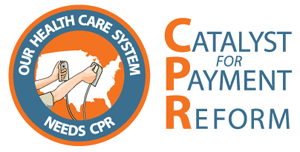 In the wake of Hurricane Sandy, there are strange bedfellows coming together this week. First strange bedfellow moment for me this week was the video of Governor Chris Christie and President Barak Obama embracing and working together in storm-turn New Jersey yesterday. Saints be praised! to see a Republican and Democrat coming together, working together, consoling citizens together.
In the wake of Hurricane Sandy, there are strange bedfellows coming together this week. First strange bedfellow moment for me this week was the video of Governor Chris Christie and President Barak Obama embracing and working together in storm-turn New Jersey yesterday. Saints be praised! to see a Republican and Democrat coming together, working together, consoling citizens together.
In health care this week, another welcome strange bedfellow event is the statement issued by Catalyst for Payment Reform (CPR), an advocacy group of business, labor unions (notably, the AFL-CIO), and consumer advocates promoting broadly available information for consumers about the price and quality of health care. The purchaser membership of CPR includes 3M, Boeing, Bloomin’ Brand s, CalPERS, Capital One, Carlson, Delta Air Lines, Dow Chemical, eBay, Equity Healthcare, FedEx, GE, Group Insurance Commission, Commonwealth of Massachusetts, Intel, Marriott, Ohio Medicaid, Ohio PERS, Safeway, South Carolina Medicaid, US Foods, Verizon, Walmart, Walt Disney Company, and Xerox. The effort is led by Suzanne Delbanco, who previously managed the Leapfrog effort promoting quality in health care.
s, CalPERS, Capital One, Carlson, Delta Air Lines, Dow Chemical, eBay, Equity Healthcare, FedEx, GE, Group Insurance Commission, Commonwealth of Massachusetts, Intel, Marriott, Ohio Medicaid, Ohio PERS, Safeway, South Carolina Medicaid, US Foods, Verizon, Walmart, Walt Disney Company, and Xerox. The effort is led by Suzanne Delbanco, who previously managed the Leapfrog effort promoting quality in health care.
Looking at the employer/purchaser members of CPR, you can see many who have been involved in their regional/state business health care coalitions. This effort crosses states for a national effort to reach across labor and industry in the best interests of patients — and the commercial payors, who support 50% of health spending in the U.S.
CPR issued a statement this week with the following key points in this consumer health transparency manifesto:
- Consumers must have access to meaningful, comprehensive information about the price and quality of services to make informed health care decisions.
- Providers and health plans must make such information available.
- Self-insured purchasers have the right to use their claims data to develop benefit designs and tools that meet their needs.
- Current anti-trust laws should be adhered to and enforced to ensure that providers and health plans do not use price information in an anti-competitive manner.
In January 2014, CPR purchasers expect providers to remove any restrictions on health plans from making price and quality information available for use in transparency tools. CPR also expects plans to allow self-insured customers — who foot the bill on premiums for their workers — to be able to fully use their own claims data including giving it to third-party vendors to develop transparency tools.
Health Populi’s Hot Points: Andy Grove, guru of Intel, recently wrote about the lack of transparency in health care in a Wired magazine article called Peeling Away Health Care’s Sticker Shock. The need for greater transparency in U.S. health care has never been greater since consumers/patients are taking on greater financial responsibility for their health costs, and employers continue to adopt consumer-driven plan models and will do so in 2013.
What’s at the core of CPR’s announcement? Aside from the importance of getting greater transparency in the market, and the call-to-arms across-the-aisles of labor and business, is issue #3 above: the assertive demand by payors/purchasers to be able to use ‘their own’ claims data for populating the information in transparency tools, such as Castlight Health, Change:Healthcare, the Leapfrog Group, among many other programs and start-ups seeking to shed light on health care pricing and quality. But these projects haven’t been able to populate their databases since health plans have blocked access to employers’ claims data — based on contractual agreements — stating that such data is “proprietary information” to the health plan.
This is akin, to those of us in the “Gimme My DAM Data” movement (where “DAM” stands for “Data About Me”), to an employer not being able to access “their” own data. More transparency = less friction in the health system, smarter decisions by consumers, and greater health engagement.




 I love sharing perspectives on what's shaping the future of health care, and appreciate the opportunity to be collaborating once again with Duke Corporate Education and a global client on 6th May. We'll be addressing some key pillars to consider in scenario planning such as growing consumerism in health care, technology (from AI to telehealth), climate change, and trust -- the key enabler for health engagement or dis-engagement and mis-information. I'm grateful to be affiliated with the corporate education provider
I love sharing perspectives on what's shaping the future of health care, and appreciate the opportunity to be collaborating once again with Duke Corporate Education and a global client on 6th May. We'll be addressing some key pillars to consider in scenario planning such as growing consumerism in health care, technology (from AI to telehealth), climate change, and trust -- the key enabler for health engagement or dis-engagement and mis-information. I'm grateful to be affiliated with the corporate education provider  Thank you FeedSpot for
Thank you FeedSpot for